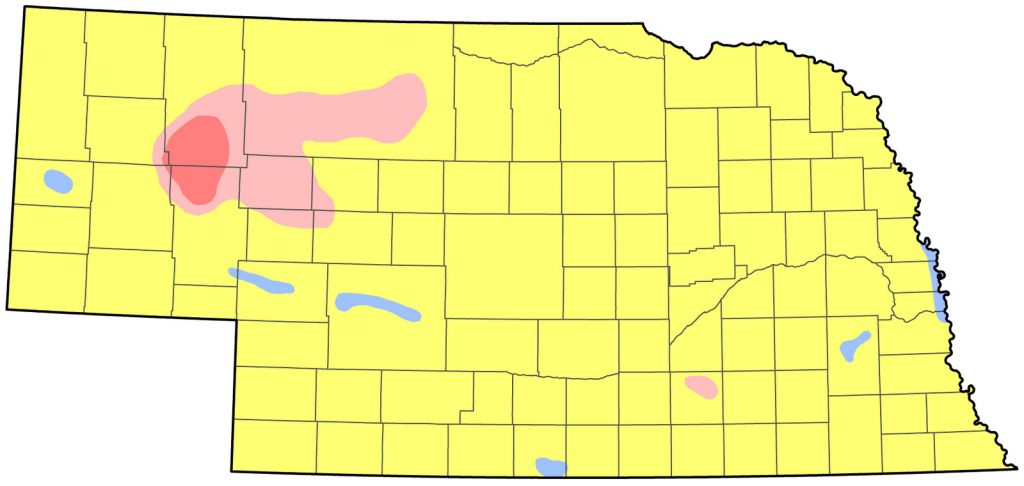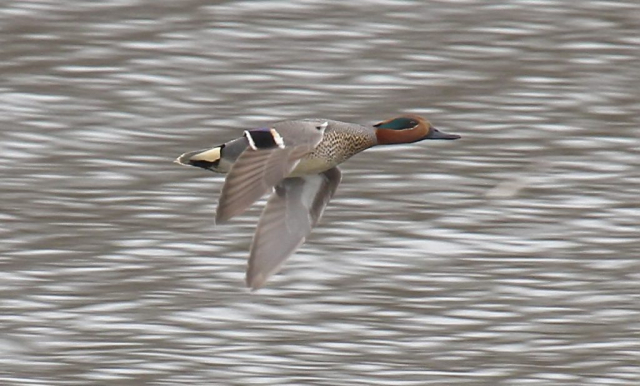Anas cRECCA CAROLINENSIS
Status: Common, locally abundant, regular spring and fall migrant statewide. Rare regular breeder northcentral, rare casual elsewhere. Uncommon summer visitor Rainwater Basin; rare casual elsewhere. Uncommon regular winter visitor west, south, east, rare north.

Documentation: Specimen: UNSM ZM12432, 14 Apr 1909 Cass Co.
Taxonomy: The Western Hemisphere carolinensis and Eurasian (including Aleutian Islands) crecca have often been treated as conspecific or as “subspecies groups”(AOU 1998). Evidence for separation has been mainly morphological, more recently supported by “highly divergent” mitochondrial DNA haplotypes between US and Russia with gene flow across Beringia (Zink 1995, Johnson et al 2020). However, recent studies (McLaughlin et al 2020, Spaulding et al 2023) showed “mitonuclear discordance” with a lack of genomic divergence along with extensive “male-dominated gene flow” (Spaulding et al 2023). As noted by Spaulding et al (2023), “deep mtDNA lineages do not always represent significant population divergences.” Most recently, AviList (2025) treated the two taxa as subspecies based on these genomic studies as well as “a lack of known differences in courtship vocalization.” Johnson et al (2020) noted that the “situation [is] finely balanced”.
Green-winged Teal is monotypic in North America away from the Aleutian Islands; Aleutian A. c. nimia is included in Eurasian A. c. crecca when two species are recognized (Gill et al 2022).
We follow AviList (2025) in recognizing carolinensis and crecca as subspecies of Green-winged Teal Anas crecca.
For Nebraska records of hybrids with Blue-winged Teal, see Blue-winged Teal x Green-winged Teal.
Spring: Feb 19, 21, 21 <<<>>> Jun 13, 14, 15
Early dates above are for the north only. Earlier dates are 11 Feb 2024 Sherman Co, and 15 Feb 2013 Blaine Co.
Late dates above are away from Sandhills and Rainwater Basin counties. For later Jun and Jul dates see Summer and Fall.
Movement begins in mid- to late Feb and reaches its peak in late Mar in the east and mid-Apr in the Panhandle, but migrants occur into early May, straggling into Jun. A rather high late count was the 146, mostly males, still at Lake McConaughy, Keith Co 14 May 2004. Late Jan and early Feb reports may be of overwintering individuals.
- High counts: 8500 at Harvard WPA, Clay Co 3 Apr 1997, 8000 at Lake McConaughy, Keith Co 21 Mar 2023, and 6300 at Harvard WPA and Mallard Haven WPA, Fillmore Co 9 Apr 2000.
Apart from Lake McConaughy, westerly counts are far lower than in the central and east, Panhandle counts rarely exceeding 200.
Summer: Green-winged Teal breeds in the western and northern Sandhills and rarely in the Rainwater Basin (Mollhoff 2016). An adult with young was at the southeastern extent of the Sandhills at Taylor Ranch, Hall Co between 20 May-2 Jun 1985 (Wayne Mollhoff, personal communication). The most recent records from the Rainwater Basin are of a nest found in Clay Co in 1985 (Harding 1986), a hen and brood at Mormon Island SRA, Hall Co 4 Jun 1986 (Wayne Mollhoff, personal communication), a female with a brood of seven at Harvard WPA, Clay Co 28 Jul 2007 (Jorgensen 2012), a brood of two unfledged but well-grown young with a female at Hultine WPA, Clay Co, 23 Aug 2008, and a hen and brood at the Ducks Unlimited Verona Complex, Clay Co 26 Jul 2015. Multiple birds were in the eastern Rainwater Basin in 2001, with 16 on 15 Jun and “several” on 1 Jul, and in 2008, when 35 were present 22 Jun.
“Quite a few pairs” on Perkins Co playas 26 May 2010 raised the possibility of breeding there, as did the 4-7 at Kiowa WMA, Scotts Bluff Co 13 Jun-18 Jul 2024.
There are few breeding season (Jun-Jul) reports away from the Sandhills and Rainwater Basin; most such reports are more likely to be of molt migrants rather than breeding birds (see Fall).
Fall: Aug 11, 12, 12 <<<>>> Dec 12, 13, 14
Early dates above are for counts >5 away from Sandhills and Rainwater Basin potential breeding areas. Earlier dates are 25 Jul 2024 (8) Scottsbluff WTP, Scotts Bluff Co, 6 Aug 2018 (12) Lancaster Co, and 7 Aug 2024 (16) Lake McConaughy, Keith Co.
Late dates above are for the north only. A later date is 19 Dec 2024 (2) Valentine, Cherry Co.
Detectable movement begins as early as mid-Jun and continues at a low level through Jul; there are numerous records statewide during this period. Males leave females while the latter are incubating and generally move southward to molt (Palmer 1976). The 23, mostly males, at a flooded field in Box Butte Co 29 Jun 2015 may have been such birds, and an eclipse male was near Ellsworth, Sheridan Co 29 Jun 2022.
True migration begins in mid- to late Aug and peak movement is during late Oct; a few linger into Dec or early Jan. Late high counts were 116 at Lake McConaughy 29 Dec 2007 and 294 there 31 Dec 2011.
- High counts: 15,100 at Lake McConaughy 31 Oct 2006, 14,000 there 14 Nov 2022, 9040 there 14 Oct 2000, 4000-5000 there 17 Sep 1994, and 4400+ there 1 Nov 1998.
Winter: Green-winged Teal are among the most likely dabbling ducks to overwinter in Nebraska; preferred sites are mostly in the south. Rosche (1994) considered Green-winged Teal a “locally uncommon to very common” winter visitant at Lake McConaughy. It is regularly reported on CBCs, including high statewide counts of 2601 in 2021-2022 and 594 in 2017-2018. Record high individual CBC tallies were set in 2023-2024: 5640 at Harlan County Reservoir 14 Dec, and 5379 at DeSoto NWR.
Reports in the north in mid-winter (20 Dec-10 Feb) are few, all but two in winter 2023-2024: 2 Jan 2021 (3) Ericson Lake, Wheeler Co, 3 Jan 2024 (4) Brown Co, up to 10 from 11 Jan-5 Feb 2023 Ericson Lake, up to 14 from 19-22 Jan 2024 Fort Niobrara NWR, Cherry Co, 26 Jan 2024 (6) Thomas Co, 29 Jan 2024 (2) 10 miles north of Hyannis in Cherry Co, 29 Jan 2025 (19) west of Merritt Reservoir, Cherry Co, and 5 Feb 2024 (5) Merritt Reservoir, Cherry Co.
- High counts: (non-CBC; the three best following here were all in winter 2023-2024) 1370 at Sutherland Reservoir, Lincoln Co 22 Dec 2023, 1000 at Lake McConaughy 21 Feb 2024, and 370 at Lake Minatare, Scotts Bluff Co (SM). Other than winter 2023-2024, high counts are 268 at Lake Ogallala, Keith Co 29 Jan 2000, 245 at Sutherland Reservoir, Lincoln Co 3 Jan 2022, and 200 at North Platte WTP, Lincoln Co 21 Dec 2024.
Images
Abbreviations
CBC: Christmas Bird Count
SRA: State Recreation Area
UNSM: University of Nebraska State Museum
WPA: Waterfowl Production Area (Federal)
Literature Cited
[AOU] American Ornithologists’ Union. 1998. The AOU Check-list of North American birds, 7th ed. Allen Press, Lawrence, Kansas, USA.
Gill, F., D. Donsker, and P. Rasmussen. 2022. IOC World Bird List (v 12.2). Doi 10.14344/IOC.ML.12.2. http://www.worldbirdnames.org/
Handbook of the Birds of the World and BirdLife International. 2020. Handbook of the Birds of the World and BirdLife International digital checklist of the birds of the world. Version 5. http://datazone.birdlife.org/userfiles/file/Species/Taxonomy/HBW-BirdLife_Checklist_v5_Dec20.zip.
Harding, R.G. 1986. Waterfowl nesting preferences and productivity in the Rainwater Basin, Nebraska. Master’s thesis, Kearney State College, Kearney, Nebraska, USA.
Johnson, K., C. Carboneras, D.A. Christie, and G.M. Kirwan. 2020. Green-winged Teal (Anas crecca), version 1.0. In Birds of the World (S. M. Billerman, Editor). Cornell Lab of Ornithology, Ithaca, NY, USA. href=”https://doi.org/10.2173/bow.gnwtea.01″>https://doi.org/10.2173/bow.gnwtea.01.
Jorgensen, J.G. 2012. Birds of the Rainwater Basin, Nebraska. Nebraska Game and Parks Commission, Lincoln, Nebraska, USA.
McLaughlin, J.F., B.C. Faircloth, T.C. Glenn, and K. Winker. 2020. Divergence, gene flow, and speciation in eight lineages of trans‐Beringian birds. Molecular Ecology 29: 3526–35.
Mollhoff, W.J. 2016. The Second Nebraska Breeding Bird Atlas. Bull. Univ. Nebraska State Museum Vol 29. University of Nebraska State Museum, Lincoln, Nebraska, USA.
Palmer, R.S., ed. 1976. Handbook of North American birds. Vol. 2. Waterfowl (Parts 1 and 2). Yale University Press, New Haven, Connecticut, USA.
Rosche, R.C. 1994. Birds of the Lake McConaughy area and the North Platte River valley, Nebraska. Published by the author, Chadron, Nebraska, USA.
Spaulding, F.R., J.F. McLaughlin, K.G. McCracken, T.C. Glenn, and K. Winker. 2023. Population genomics indicate three different modes of divergence and speciation with gene flow in the Green-winged Teal duck complex. Molecular Phylogenetics and Evolution 182: 107733.
Zink, R.M., S. Rohwer, A.V. Andreev, and D.L. Dittman. 1995. Trans-Beringia comparisons of mitochondrial DNA differentiation in birds. Condor 97: 639–649.
Recommended Citation
Silcock, W.R., and J.G. Jorgensen. 2025. Green-winged Teal (Anas carolinensis). In Birds of Nebraska — Online. www.BirdsofNebraska.org
Birds of Nebraska – Online
Updated 6 Jul 2025

